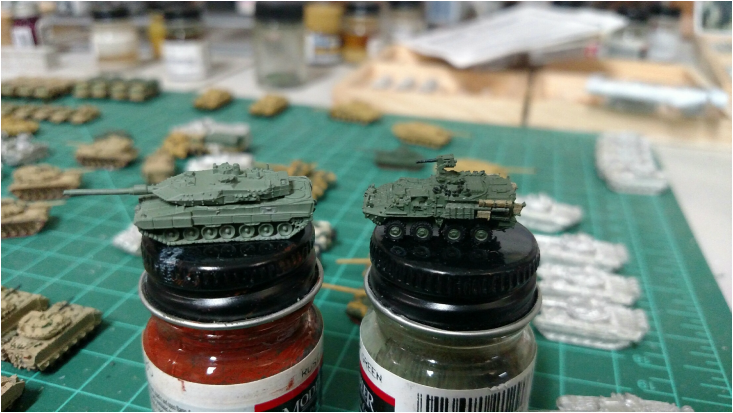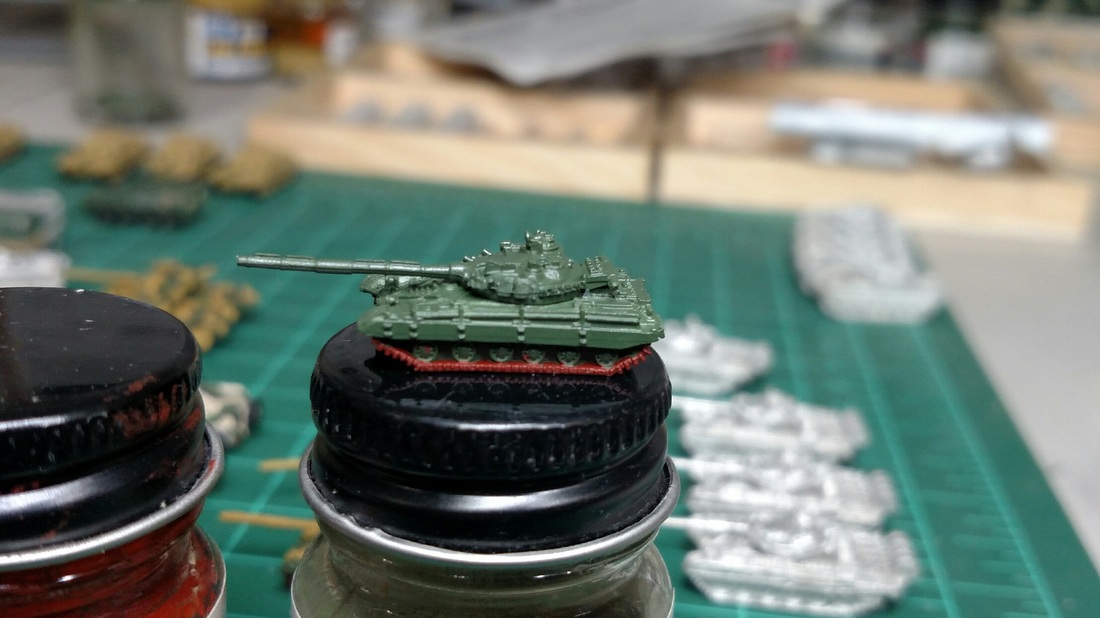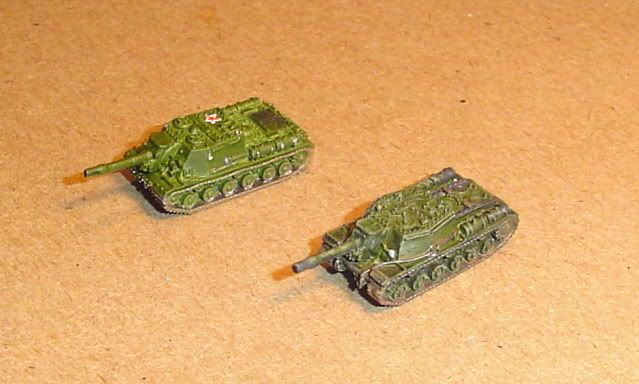Page 1 of 1
Base Coat Whitening
Posted: Wed Dec 16, 2015 12:17 pm
by Hoth_902
My newest project, to add to the growing backlog of unfinished projects, is a Leopard 2A6. I am using Model Masters Tricolor Green NATO (S6). When viewed in the bottle it appears to be the right shade of green, however when applied it looks a little dark. Now this in itself is not a huge deal, but I have read on this website that at this scale, a little white should be added to lighten up the color... I presume its to be able to see the detail and to assist in the wash process to help the detail pop out. That being said, I took the Tricolor Green NATO and added about 10% flat white to it. The results were not to what I was looking for. The Leopard is done in the lightened color and the Stryker is painted with color strait from the bottle. My issue is, what is the right amount of white to add so that the final product does not look too faded. See results below.

The soviet tank below has no white added and it appears to be too dark. It uses Model Masters Russian Armor Green. When I tried to lighten the green, in the same proportions mentioned above, it turned out like a very washed out pale green. The picture below looks lighter than it does in person.

Maybe I am making too much out of this and the darker color is just fine or maybe the lighter color on the leopard just needs to be darkened up a little. My goal is to paint the Leopard using the NATO Tri Color of Green base, Black and Brown camo pattern. Any advice or opinion would be greatly appreciated. Thanks in advance.
Posted: Wed Dec 16, 2015 2:18 pm
by chrisswim
Hoth,
Have you put the other colors on the vehicle yet to see how the camo works together? It may be worse or better. Sometimes a darker color will work in this camo scheme.
.
For my 3-color camo, I spray paint medium green, then use military brown, then black.
PM you email to me, I will send you pictures. There might be some picture on FB: Chris's Micro Armor page.
Posted: Wed Dec 16, 2015 8:05 pm
by paul
Hoth,
Once you add a wash and then highlight the vehicle, I think you will get a brighter vehicle. I do not mix anything with my base coat to lighten the model. Could be wrong but it is what you want. The Leo does not look bad either.
Posted: Wed Dec 16, 2015 8:51 pm
by Extra Crispy
I rarely use white to lighten colors. It tends to make colors go "pastel." Instead, I often use a lighter shade. So mix light green with dark green, or sky blue with navy blue. Some times I use flesh or a pale sand color, something with a little yellow in it, again to prevent that "pastel" effect.
I'd say I usually go for more than 10%. I would say 20-33% is more typical, using colors other than white.
Posted: Thu Dec 17, 2015 10:44 am
by Hoth_902
Chrisswim,
PM sent. I look forward to picture and any advice you can provide.
Paul,
I have some vehicles that I have not lightened. The strykers are the way. The Leo looks good in that picture but in reality, it look petty pale.
Extra Crispy,
Thanks for the advice. Especially recommending the use of a lighter shade of the same color and for the percentages that you use. I am a leap before looking and mixed up and entire bottle with the white.. So now I have plenty of lighter green to play with and mix with the out of the bottle color. I will try and start with a smaller batch and see where it leads me.
Thanks everyone for your help and advice.
Posted: Thu Dec 17, 2015 3:17 pm
by Mk 1
My approach is not to whiten the paint I use for the base coat, but rather to prime the models with white primer before applying the base coat.
This provides much of the benefit of lightening the overall color to compensate for the "scale effect" (using the same tone of paint, a smaller model will appear darker than a larger model seen from a distance). But it compensates for the scale effect while adding a bit of highlighting, as the base coat will not be as thick on the raised parts of the model as on the flat surfaces, and the flat surfaces will not be coated as thickly as the recesses.
So you get an overall lightening, but not the washing-out effect of just mixing some white paint in with your base coat.
If you are interested, the primer I use is a brand called Krylon, which I find at any local auto-parts or hardware store. Big can, small price, excellent adhesion, and very easy to get a thin even coating.
At least that's how I like to approach it. Your mileage may vary.
Posted: Tue Dec 22, 2015 9:04 pm
by panzergator
I favor the white primer, too. Easier for my old eyes to see the detail. Try applying the black wash after the primer to darken the crevices and make sure no white is visible. First camo coat after that, then away you go. Go delicately and conservatively on that wash, however. Remember scale, distance, and perspective.
Posted: Wed Dec 23, 2015 2:04 am
by Mk 1

Thought I might provide a pic to illustrate the effect of white priming.
This photo provides a comparison of some different painting techniques. Both the SU-152 and the ISU-152 have had the same base coat color applied (Testors Model Master Medium Forest Green). The ISU-152 in the background was painted in the late 1990s, before I learned the techniques of washes and dry-brushing. So all you see is the effect of the white primer beneath the base coat. The SU-152 in the foreground was done with white primer and the same base color, but has had a rather heavy black wash applied, and you can see how it has darkened the overall result.
What you see on the ISU-152 (background) is the highlighting and lightening of the base color that results from white primer. It is a simple step to prime with white, it improves the paint adherence, and it provides a scale-effect correction (lightening) without making the model look "washed out".
At least, that's my view. Your mileage may vary.




